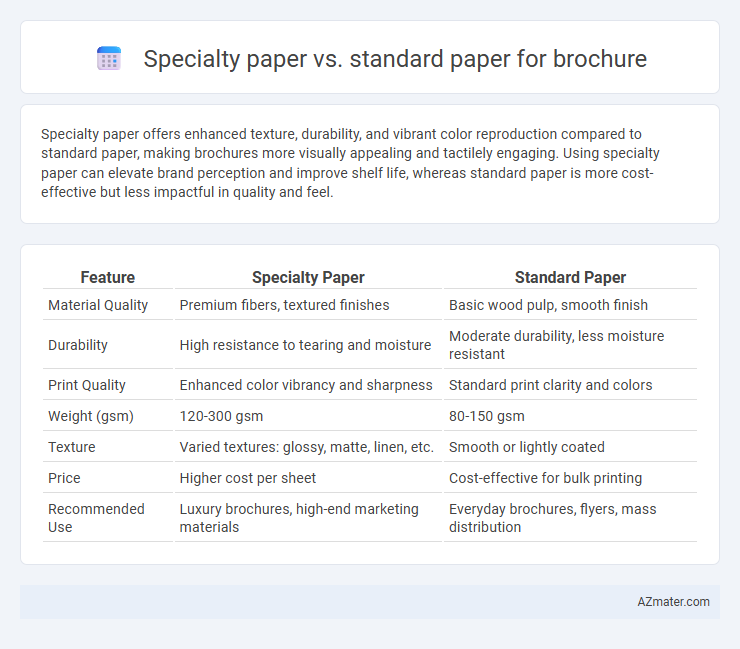Specialty paper offers enhanced texture, durability, and vibrant color reproduction compared to standard paper, making brochures more visually appealing and tactilely engaging. Using specialty paper can elevate brand perception and improve shelf life, whereas standard paper is more cost-effective but less impactful in quality and feel.
Table of Comparison
| Feature | Specialty Paper | Standard Paper |
|---|---|---|
| Material Quality | Premium fibers, textured finishes | Basic wood pulp, smooth finish |
| Durability | High resistance to tearing and moisture | Moderate durability, less moisture resistant |
| Print Quality | Enhanced color vibrancy and sharpness | Standard print clarity and colors |
| Weight (gsm) | 120-300 gsm | 80-150 gsm |
| Texture | Varied textures: glossy, matte, linen, etc. | Smooth or lightly coated |
| Price | Higher cost per sheet | Cost-effective for bulk printing |
| Recommended Use | Luxury brochures, high-end marketing materials | Everyday brochures, flyers, mass distribution |
Introduction to Brochure Paper Choices
Specialty paper offers unique textures, finishes, and weights that enhance the visual appeal and tactile experience of brochures, making them ideal for premium or branded marketing materials. Standard paper, typically coated or uncoated, provides a cost-effective solution with reliable print quality suitable for bulk production and everyday use. Choosing between specialty and standard paper depends on the desired impact, budget, and distribution goals for the brochure.
What is Specialty Paper?
Specialty paper is designed with unique textures, finishes, and weights to enhance the visual appeal and tactile experience of brochures, offering superior print quality and durability compared to standard paper. It includes options such as vellum, linen, textured, and metallic finishes that elevate brand perception through distinct aesthetics and premium feel. Unlike standard paper, specialty paper supports vibrant colors and sharp images, making it ideal for high-impact marketing materials that demand exceptional presentation.
What Defines Standard Paper?
Standard paper for brochures typically refers to coated or uncoated offset paper with a weight of 70-100 gsm, providing a smooth, matte, or gloss finish ideal for everyday printing. It is designed for cost-effectiveness, consistent print quality, and wide availability, making it suitable for bulk distribution flyers and general marketing materials. Specialty paper, by contrast, offers unique textures, heavier weights, or finishes like silk, linen, or recycled fibers that enhance tactile appeal and visual impact for premium brochures.
Visual Appeal: Specialty vs Standard Paper
Specialty paper enhances visual appeal for brochures through unique textures, finishes, and vibrant color reproduction that standard paper cannot match. Coated specialty papers, such as glossy or satin, offer sharper images and more vivid colors, making promotional materials more eye-catching and professional. Standard paper typically lacks these features, resulting in duller visuals that may not engage the audience as effectively.
Durability and Quality Comparison
Specialty paper used for brochures offers superior durability with enhanced tear resistance and moisture protection compared to standard paper, ensuring longevity and a premium feel. The higher density and unique coatings of specialty paper improve print quality by delivering sharper images and more vibrant colors, resulting in visually striking brochures. Standard paper generally lacks these protective features and print enhancement qualities, making it less suitable for high-end marketing materials requiring lasting impact.
Printing Results and Color Vibrancy
Specialty paper offers superior printing results and enhanced color vibrancy compared to standard paper, making brochures more visually striking and professional. Its unique coatings and textures allow ink to adhere better, resulting in sharper images and richer, more vivid colors. Standard paper often absorbs ink unevenly, leading to duller colors and less precise details in printed brochures.
Cost Considerations and Budget Impact
Specialty paper for brochures often carries a higher cost due to its unique textures, finishes, and durability compared to standard paper, impacting the overall printing budget significantly. Businesses should evaluate the purpose and target audience of the brochure to determine if the increased expense of specialty paper will yield a better return on investment through enhanced brand perception. Selecting standard paper offers cost-efficiency and faster turnaround, making it suitable for large volume distributions or budget-conscious projects without compromising basic print quality.
Eco-Friendliness and Sustainability
Specialty paper for brochures often utilizes recycled fibers and sustainable sourcing practices, resulting in a lower environmental impact compared to standard paper, which typically relies on virgin pulp from non-renewable sources. Specialty papers may also incorporate eco-friendly coatings and additives designed to be biodegradable or recyclable, enhancing their sustainability profile and reducing landfill waste. Choosing specialty paper supports eco-conscious branding by prioritizing renewable materials and minimizing carbon footprint throughout the production cycle.
Ideal Use Cases for Each Paper Type
Specialty paper, including textured or heavily coated options, enhances visual appeal and tactile experience, making it ideal for luxury or high-impact brochures such as art catalogs, premium product launches, and corporate portfolios. Standard paper offers cost-effective durability and readability, suitable for mass distribution brochures like event programs, educational materials, and promotional flyers. Choosing paper based on the brochure's purpose and target audience optimizes impression and budget efficiency.
Choosing the Right Paper for Your Brochure
Specialty paper for brochures enhances visual impact with unique textures, finishes, and durability, making it ideal for premium branding and long-lasting impressions. Standard paper offers cost-effective options with smooth, consistent printing surfaces suitable for high-volume distribution and general marketing needs. Selecting the right paper depends on your brochure's purpose, target audience, and budget to balance quality and practicality effectively.

Infographic: Specialty paper vs Standard paper for Brochure
 azmater.com
azmater.com